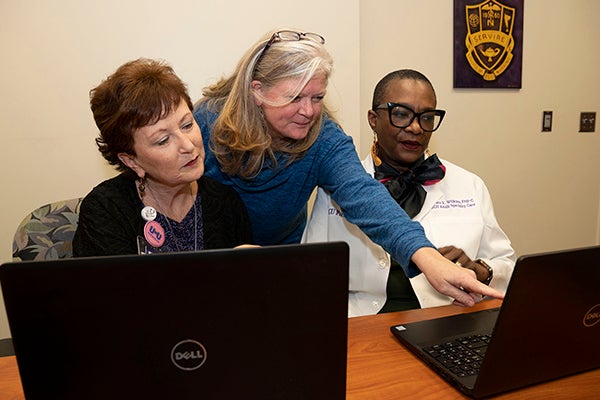Nursing researcher breaks communication barriers with HIV-positive women
One thread that East Carolina University health sciences researchers keep pulling at to unravel the heavy burden of chronic disease in eastern North Carolina is disconnectedness.
Many of the people with the greatest need are in a place of need because of lack — lack of opportunity and lack of resources. Most importantly, a lack of connection.
Courtney Caiola, an assistant professor of nursing and researcher focusing on women and HIV, said that that the HIV epidemic has made an insidious shift, from largely affecting urban populations in the epidemic’s early days to now having taken root in rural and underserved regions — and eastern North Carolina has become a ready refuge for the disease.

Courtney Caiola speaks with Community/Clinician Advisory Board members Donna Roberson and Grace Wilkins about her HIV research with women in rural areas of North Carolina. (ECU file photo)
The National Institute of Nursing Research has funded one of Caiola’s research projects that aims to find out how best to communicate with women living with HIV in rural settings, particularly for those without reliable access to high-speed internet connectivity.
“If (patients) are engaged in care and taking medications, they often live long, healthy lives. But the issue is that regionally, the epidemic has shifted from more urban areas to more rural areas, and specifically the south,” Caiola said.
Her current study is broken into three distinct phases. First researchers will interview a small cohort of women living with HIV to determine what their challenges are to engaging in care and sticking to a treatment regimen. This initial feedback will inform surveys that will be given to larger groups of women, which is the stage Caiola and her team are at. The third phase will see focus groups held in rural communities to evaluate the effectiveness of planned messaging to women who might be on the fence about seeking treatment or who need a little extra encouragement to keep on track with taking medications and following health promoting behaviors.
Caiola is fighting an uphill battle, one complicated with social mores and community stigma for residents of rural and underserved area who are diagnosed with HIV.
“The epidemic has changed over the years, in good ways,” Caiola said. “People living with HIV are living really well now, but women living with HIV in the south have some of the highest rates of HIV infection but the lowest rates of viral suppression, which means that that they’re not engaged in care.”
Caiola said that cultural barriers and social stigma often prevent many women in the region from seeking care. While a woman in a more urban setting might be able to visit an HIV clinic with little fear of disclosing her HIV status, that isn’t the case when community members know which clinics serve patient’s living with HIV. Also, a simple lack of knowledge of how the virus is transmitted continues to stigmatize those who are living with HIV.
“Where people sit. Being given plastic plates as opposed to everybody else eating off a regular plate when you go to a community event, those kinds of things. There are still very overt, stigmatizing experiences that are not founded in fact,” Caiola said.
Partnering with CAHS
Caiola’s research partners well with an outreach and research project spearheaded by Leigh Atherton, an associate professor in the College of Allied Health Science’s Department of Addictions and Rehabilitation Studies. The project seeks to find ways to prevent the spread of HIV in rural North Carolina by encouraging those in high-risk substance use groups to seek treatment for their addictions. Atherton’s team partners with community-based HIV outreach groups and supplements testing supplies, which puts his counselors in direct contact with at-risk populations.
“We provide them additional resources to get testing supplies, which increases HIV and Hepatitis C testing availability by providing the resources. That brings the substance use treatment and a brief addiction intervention to the process, which allows us to link and coordinate HIV and Hepatitis C treatment with addictions treatment,” Atherton said.
Like Caiola’s research, the goal of Atherton’s program is to find new ways of identifying the most at-risk members of underserved communities to reduce harm on all levels.
One of the highest hurdles to clear for researchers focused of HIV treatment and prevention in North Carolina is simply getting enough people to participate in the research. Caiola and her team have been hampered to the point of having to broaden their research from just North Carolina to include other states in the region in order to find the 200 participants they hope to gather. She has partnered with researchers at Vanderbilt University in Tennessee and Temple University in Pennsylvania.
“There’s something called courtesy stigma. A lot of women with HIV are mothers and they don’t want the stigma that they might experience to be passed on to their kids, so they tend to keep very low profiles and be a bit socially isolated,” Caiola said, which necessitated her team partnering with multiple other HIV researchers in North Carolina and across the south.
Initial research findings are beginning to shed light on the challenges communicating with rural women dealing with a stigmatizing disease: in short there is no one-size-fits-all solution. In previous studies Ciaola found that understanding the nuances of people’s experiences is critical for tailoring interventions.
“As clinicians, the differences in the way people respond to their circumstances is often very clear, but in research, people are often grouped into broad demographic groups for the sake of generalizability,” Ciaola said. “In fact, two women with similar demographic profiles, like Black women living with HIV in a rural area, may have wildly different responses to dealing with HIV.”
“We have a very specific, stratified sampling plan, where we are really focusing on different populations like rural versus non-rural, (women living) above the poverty line below the poverty line, different racial groups. Hopefully we’re getting a very broad perspective of people’s experiences,” Caiola said.